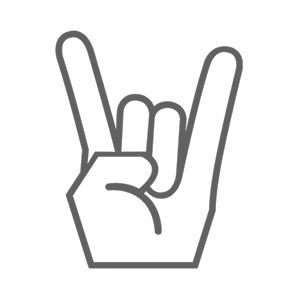The sign of the horns is a hand gesture with a variety of meanings and uses in various cultures. It is formed by extending the index and little fingers while holding the middle and ring fingers down with the thumb. When confronted with unfortunate events, or simply when these are mentioned, the sign of the horns may be given to ward off bad luck. It is a more vulgar equivalent of ‘knocking on wood.’
One can also ‘touch iron’ (‘tocca ferro’) or touch one’s nose. Males in some countries may grab their testicles, which is considered very vulgar. In Peru one says ‘contra’ (‘against’). In the Dominican Republic the expression is ‘zafa,’ said against curses. All of these gestures are meant to conjure supernatural protection. However, the sign of horns is used in Brazil, Cuba, Italy, Portugal, Spain and Uruguay to indicate a man whose wife is unfaithful.
In Italy, pointing the index and little finger at someone is a common curse as well as an accusation of having an unfaithful wife (also note that a common italian word for cuckolded is ‘cornuto,’ which literally means ‘horned’). With fingers down, it is a common apotropaic (warding off spirits) gesture instead, by which superstitious people seek protection in unlucky situations (something like touching wood). Thus for example the President of the Italian Republic Giovanni Leone shocked the country when, while in Naples during an outbreak of cholera, he shook the hands of patients with one hand while with the other behind his back he made the corna. This act was well documented by the journalists and photographers who were right behind him, a fact that had escaped President Leone’s mind in that moment. The gesture was interpreted as especially offensive for the patients. It is much more common in southern Italy, and is typical in the popular culture of Naples, where President Leone was born.
The 1969 back album cover for ‘Witchcraft Destroys Minds & Reaps Souls’ by Chicago-based psychedelic-occult rock band Coven, led by singer Jinx Dawson, pictured Coven band members giving the ‘sign of the horns’ correctly and included a Black Mass poster showing members at a ritual making the sign. Starting in early 1968, Coven concerts always began and ended with Jinx giving the sign on stage.
On the cover of The Beatles’ ‘Yellow Submarine’ album (1969), the cartoon of John Lennon’s right hand is making the sign above Paul McCartney’s head. For many fans, this was one of the many ‘Paul is dead’ clues. Some may think it is possible that the cartoonist misrepresented the sign for ‘I love you,’ which is very similar and more in keeping with the band’s public message and image. However, the 1969 cartoon is based on many photos of John Lennon making the hand sign in 1967. One of these photos of Lennon doing the hand sign appears on the cover of a Beatles single release shortly after, making it the first time the hand sign appears on a rock release.
Beginning in the early 1970s, the horns were known to some as the ‘P-Funk sign’ to fans of Parliament-Funkadelic. It was used by George Clinton and Bootsy Collins as the password to the Mothership, a central element in Parliament’s science-fiction mythology, and fans used it in return to show their enthusiasm for the band. Collins is depicted showing the P-Funk sign on the cover of his 1977 album ‘Ahh… The Name Is Bootsy, Baby!’
It also has a variety of meanings in heavy metal subcultures, where it is known by a variety of terms, most commonly maloik, metal sign, or Leviathan Horns, among others. A 1985 article in ‘Circus’ by Ben Liemer states that Gene Simmons of Kiss was influenced by Blackie Lawless of W.A.S.P. in 1977 after watching Sister perform in Los Angeles. Blackie had come across a hand salute known as the corna in an occult book and had started using it during live performances. Though this is thought to be untrue as Gene can clearly be seen making the gesture in a well-known 1975 live concert filmed at the Winterland Ballroom, San Francisco.
Ronnie James Dio was known for popularizing the sign of the horns in heavy metal. His Italian grandmother used it to ward off the evil eye (which is known in the Italian culture as ‘malocchio’). Dio began using the sign soon after joining (1979) the metal band Black Sabbath. The previous singer in the band, Ozzy Osbourne, was rather well known at using the ‘peace’ sign at concerts, raising the index and middle finger in the form of a ‘V.’ Dio, in an attempt to connect with the fans, wanted to similarly use a hand gesture. However, not wanting to copy Osbourne, he chose to use the sign his grandmother always made. The horns became famous in metal concerts very soon after Black Sabbath’s first tour with Dio. The sign would later be appropriated by heavy metal fans under the name ‘maloik,’ a corruption of the original malocchio.
However, Terry ‘Geezer’ Butler of Black Sabbath can be seen ‘raising the horns’ in a photograph taken in 1971. This would indicate that the ‘horns’ and their association with metal occurred much earlier than either Gene Simmons or Ronnie James Dio suggests. In 2001 ‘Metal-Rules.com’ asked Dio: ‘I want to ask you about something people have asked you about before but will no doubt continue to talk about, and that is the sign created by raising your index and little finger. Some call it the ‘evil eye.’ I would like to know if you were the first one to introduce this to the metal world and what this symbol represents to you?’ Dio responded, ‘I doubt very much if I would be the first one who ever did that. That’s like saying I invented the wheel, I’m sure someone did that at some other point. I think you’d have to say that I made it fashionable.’
The Daily Omnivore
Everything is Interesting



Leave a comment